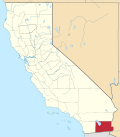
Hedges, later renamed Tumco, is a locale, a ghost town, site of a former mining town, in Imperial County, California. It lies at an elevation of 617 feet / 188 meters along the Tumco Wash in the Cargo Muchacho Mountains. [1] Nearby is the Hedges Cemetery at an elevation of 643 feet (196 meters), at 32°53′04″N114°49′52″W / 32.88444°N 114.83111°W . [2]


